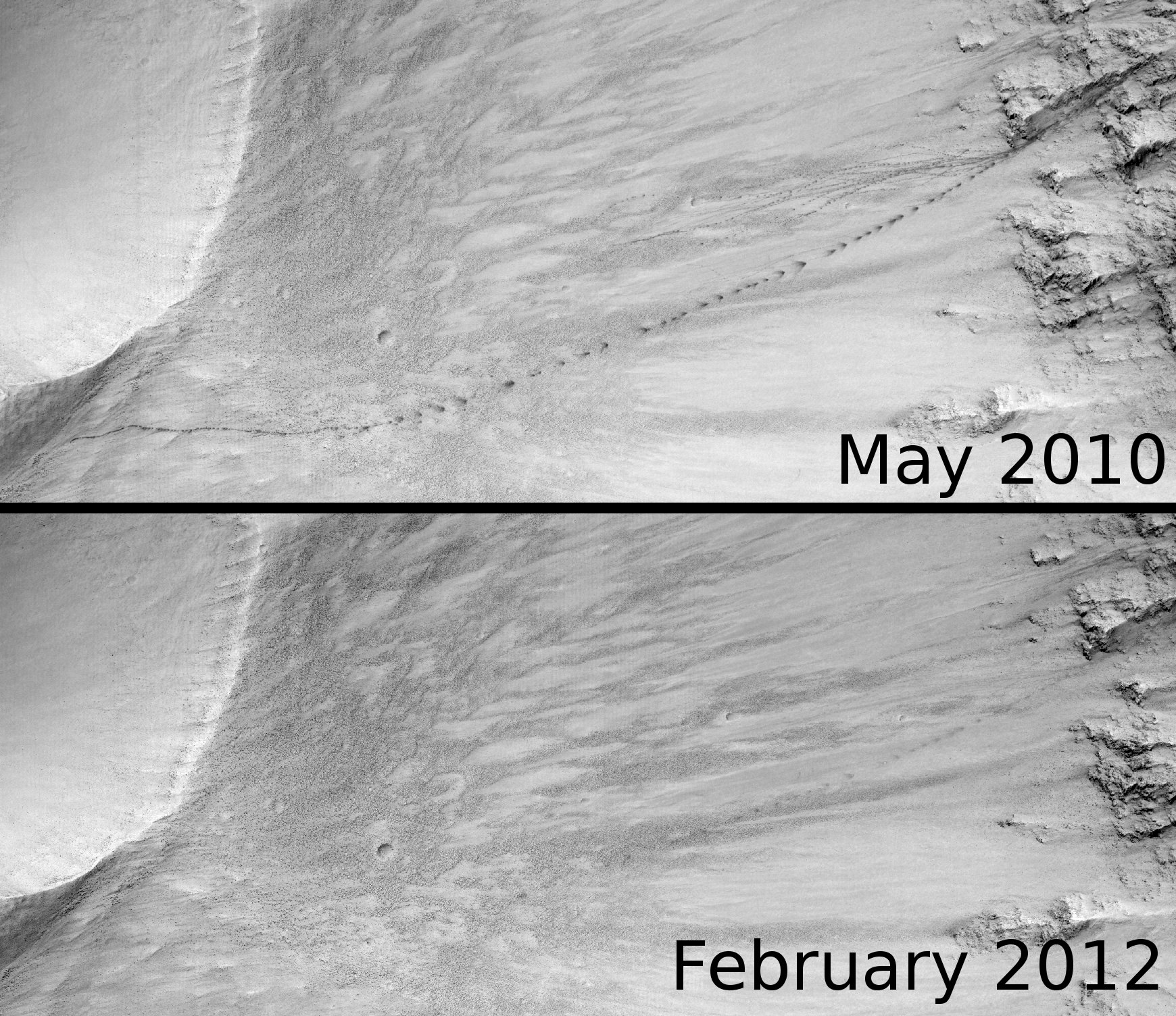[/caption]
More proof that Mars is an ever-changing world: In 2010, the Mars Reconnaissance Orbiter’s HiRISE camera spotted evidence that a boulder had rolled down an incline in a crater. The boulder left a visible track in the Martian regolith big enough to be spotted by MRO. But just one Martian year later, the tracks are gone, erased from existence.
“This is most likely due to the fine bright dust that is transported in the atmosphere falling down and re-covering the dark markings,” wrote Ross A. Beyer on the HiRISE site.
Beyer said the boulder tracks are much darker because as the boulders roll “they set off miniature dust avalanches. The bright, fine dust slides away, leaving a darker, larger grained dust underneath.”
How do boulders start moving on Mars? The boulders were disturbed in some way, breaking them loose from the crater edge, and there are two different possibilities. One, is that a meteorite impact or other tremor shook the boulder loose. Another possibility, as in the case of avalanches MRO has seen on Mars, the spring thawing of frozen carbon dioxide which forms during the Martian winter can cause rocks and debris to break loose from a cliff or incline.
Mars is certainly not the dead world we once thought it was, and the power of HiRISE keeps revealing a changing, unpredicatable landscape.


Another cause may be simple temperature changes? That is to say, the expansion/contraction of materials when exposed to solar radiation.
Honestly… someone should go up there with a good vacuum and full dance ticket- and bust some dust!
Spraking of dust… ahem… Martian dust is apparently a VERY different critter than the simple ‘dust bunny’ terrestrial stuff and fluff. Fulla charged particles from Sol, some of it’s loftiness is due to electrostatic charge and has no earthly comparison.
I am an advocate of the idea that soils on Mars behave FAR differently than what we are familiar with. When Martian dust particles are accelerated by surface winds, for whatever reason, be they perihelion warming effects or impact induced temperature variations creating atmospheric pressure changes, those particles while held in suspension can effectively become a ‘liquid’.
Liquids have, as you know, have some very interesting characteristics, especially in the transportation of larger or bulk materials, combined with subsequent kinetic erosional effects.
Hmm… sandblasted on Mars indeed… then flooded with mud and liquifacted. Bummer… in the summer?
I doubt that CME passages has any effect on dust particles on Mars.
The CME is spread so thin and the atmosphere is still thick enouh to have zero effect.
Do not underestimate the effects of electromagnetic radiation in a Coronal Mass Ejection. Mars has relatively no mag. field to deflect that energy AND Mars very tenuous atmosphere barely deflects a CME passage AND that Mars gravity is 38% that of Earth…
Try this: “Large flares are often associated with huge ejections of mass from the Sun, although the association is not clear. These coronal mass ejections (CMEs) are balloon-shaped bursts of solar wind rising above the solar corona, expanding as they climb. Solar plasma is heated to tens of millions of degrees, and electrons, protons, and heavy nuclei are accelerated to near the speed of light. The super-heated electrons from CMEs move along the magnetic field lines faster than the solar wind can flow. Rearrangement of the magnetic field, and solar flares may result in the formation of a shock that accelerates particles ahead of the CME loop. Each CME releases up to 100 billion kg (220 billion lb) of this material, and the speed of the ejection can reach 1000 km/second (2 million mph) in some flares. Solar flares and CMEs are currently the biggest “explosions” in our solar system, roughly approaching the power in ONE BILLION hydrogen bombs!”
Perhaps the MSL will provide key info which will prove or disprove my statement? Meanwhile, today’s APOD 04.22.12 has a very interesting image of the Mars landscape. http://apod.nasa.gov/apod/astropix.html
Lies. I still see them faintly.
yeah… i saw that too, three, four…
Yup, although much moire faint, definitely still there. What’s wrong with the OP?
Yah, next thing you know they’ll be saying we landed on the moon!
(this post brought to you by the concept of sarcasm)
What’s wrong with good old fashioned wind as the explanation for both? Ejecta boulder falls into dust, on slope wind blows dust away, boulder rolls downhill, wind blows dust over tracks (a bit), repeat. Maybe I’m just not scientific enough…
Re: Aqua4U and the nature of the dust likely being different. I’ve not heard of any studies showing major differences at the macro level, that’s not to say I’ve looked hard. I know long runout avalances have been looked at but I would have thought Geologists (Areologists?) would have headlined any unique features like those imagined by Paul McAuly in the novel Red Dust.